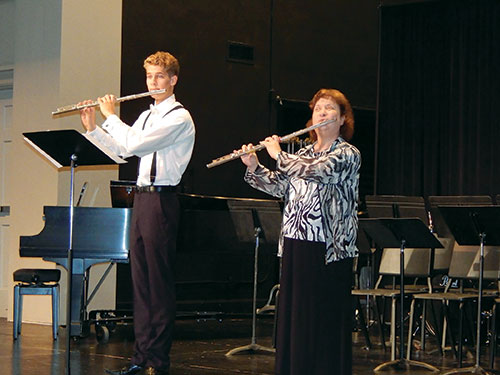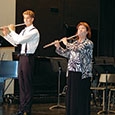
The topic of music memorization is one that is often left to the individual, as each musician develops his or her own style and method. Music notation is just black ink on white paper. Memorization allows musicians to raise their heads out of the page to express the emotions intended by the composer. When a musician steps away from the written notes there are endless options to convey emotions, atmosphere, and expressions. There are certain principles that help guide purposeful memorization. This is different from simply memorizing for the sake of a performance or competition. Purposeful memorization means to deliberately commit music into the long-term memory.
While music memorization for most musicians is an added benefit to improve performance, for flutist Sheryl Goodnight, it is a necessity because she is legally blind. At age six she was formally diagnosed with retinitis pigmentosa, a genetic disorder that causes nighttime blindness, no peripheral vision, and nearsightedness. Her vision gradually worsened over time. At first, she could manage with music enlargements, but by age 26, the contrast of black notes against white paper became indistinguishable. It was at this time that she was faced with the challenge of committing all pieces of music in her current and future repertoire to memory. Today, with more than 40 years of experience memorizing music and over 100 major works committed to memory, she is considered an expert on the topic.
When I began studying flute with Sheryl in 2013, I was amazed by not only the sheer amount of works in her memory bank, but also the many details and nuances in her playing. True memorization of a musical work is more than inscribing the notes on the page into one’s head. The following tips for music memorization can be utilized by both experienced musicians and students as a starting point for long-term memorization.
Musical Structure & Form
The first step is to look at the overall form – sonata, binary, ternary, theme and variations, etc. Next, label the tonal centers and where the keys change and modulate. However, writing too much information on the page can be counterproductive. Rather than marking up the part, one technique that is helpful is to have a separate sheet of paper on which you can write out the form, using rehearsal letters and numbers as landmarks, filling in the space between with any pertinent information. This creates a visual template on which you can see the work as a whole and look at the macro picture of memorization.
Sheryl recommends examining how the composer develops the melodies. Is he extending the melodies in terms of the new key areas or just using fragments of them in the development? She teaches that part of understanding structure and form is the ability to recognize patterns, both harmonically and melodically. Listening to and analyzing the harmonic progressions in a piece is an inseparable part of understanding the harmonic form and how the melody layers in. Look for scales, arpeggios, and thirds as well as the use of contrary motion, oblique motion, parallel motion and so on. After studying the overall structure of the work, go through and ask what is different about particular passages or phrases. How is the recapitulation different from the initial exposition, or how are the A and B themes used throughout the recapitulation? Even if it is something as small as a dynamic or note change, find what is different in the music and commit those turning points to memory.
Rehearsal Numbers and Phrasing
It has been Sheryl’s experience that rehearsal letters and numbers hold more use than merely indicating where to stop and start in rehearsals. They often are helpful in discerning sections in the overall layout of the piece. For instance, in Tchaikovsky’s Romeo and Juliet Overture, the work follows more of a free form, or multi-structure layout, than a single form such as a rondo. This makes the rehearsal letters important signposts. The Allegro gusto section of this overture, from rehearsal letter D through F, is very rhythmic, and is similar to the section from M to O. Finding the relationship of rehearsal markings to form can be helpful in tying smaller sections together. The more contextual tips one remembers about the music, such as the form, tonal centers, and rehearsal markings, the more avenues the brain has available to later access the information. Utilize these markings to connect micro ideas in the music to the macro analysis and understanding of the piece.
Understanding Rests
Know what is going on in the rests of the music, whether playing with a large symphony, wind ensemble, or pianist. From her experience as an orchestral flutist, Sheryl says that knowing what is happening when you are not playing will help you understand the phrase structure without the gaps and is a crucial part of memorization. Going back to Tchaikovsky’s Romeo and Juliet Overture, there is a melodic passage in the flute part that is proceeded by a section of rests, during which the cello leads into and sets up the flute passage with similar melodic ideas. Knowing what to listen for before and after an entrance helps players understand how that part fits into the piece. While listening to a piece of music in its entirety before a rehearsal is expected, having a full score to study while listening is even better.
In Prokofiev’s Peter and the Wolf understanding the other parts in the ensemble and how they interact is the only way to hold the open dialogue this piece requires of its players. This understanding helps players organize the melodic and harmonic material and vertical and horizontal alignment much better than just counting large groups of rests alone. Thinking and listening to other parts, both in rests and while playing, improves ensemble awareness and plays an important role in musicianship and memorization.
Breathing and Ensemble Awareness
Music begins, is sustained, and ultimately concludes with a breath, making it a vital part of ensemble communication. Listening to ensemble breathing is crucial for timing. Sheryl says that listening for breaths helps with entrances, especially when the entire ensemble has a rest together. She goes on to say that you must enter and exit a phrase or line of music together as a unit, and not as individuals. One way to incorporate ensemble listening in your practice is to record the rehearsal and then listen to the recording during practice sessions. Sheryl recommends recording, with the permission of the director, some if not all rehearsals. They often catch the things players are too busy to notice.
Listening to those around you and reacting to each other helps create a unified ambiance. Long-term comprehensive memorization is far more than knowing and understanding one’s own part; it is about connecting, understanding, and feeling together with others through collaboration.
Practice
While repetition is key in memorization, be careful to avoid practicing and consequently memorizing mistakes. It is important to practice at a tempo in which you can achieve complete success, slowing down to whatever tempo will allow your muscles to memorize correct notes and rhythms. In order to play fast passages, you must practice perfection not tempo. Practice playing from one section to another freely and with a flowing quality because the expectation at the first rehearsal of an orchestra is that all parts are learned and ready to be molded together. Practicing this will also help the brain compartmentalize micro sections into a macro idea, helping to aid the mind in long-term memory of large works. This is not to say that practice cannot include working sectionally or in small chunks, as isolation has its benefits. When practicing at letter C, make sure to go back and combine that section with playing from letter B-D to connect the sections. Making the connection fluidly from one section to another is crucial for memorization.
Music memorization is an inevitable and important part of being a performing musician today. These tips are a starting point to aid in the development of personal strategies. Œ.





